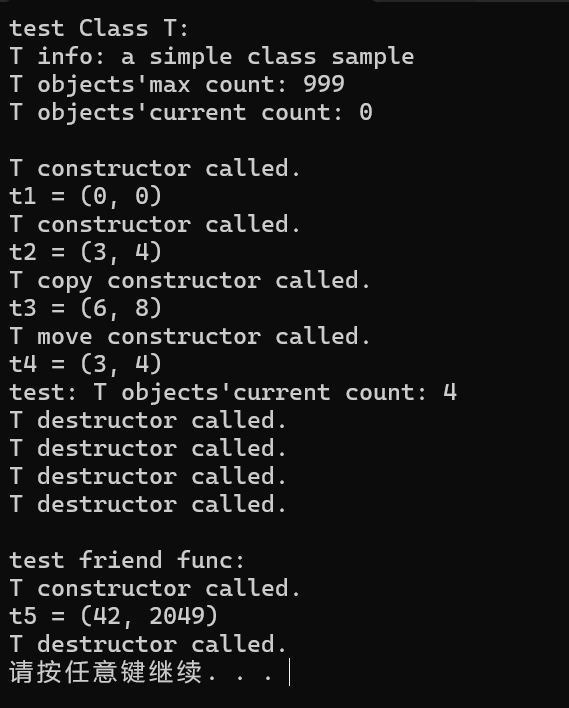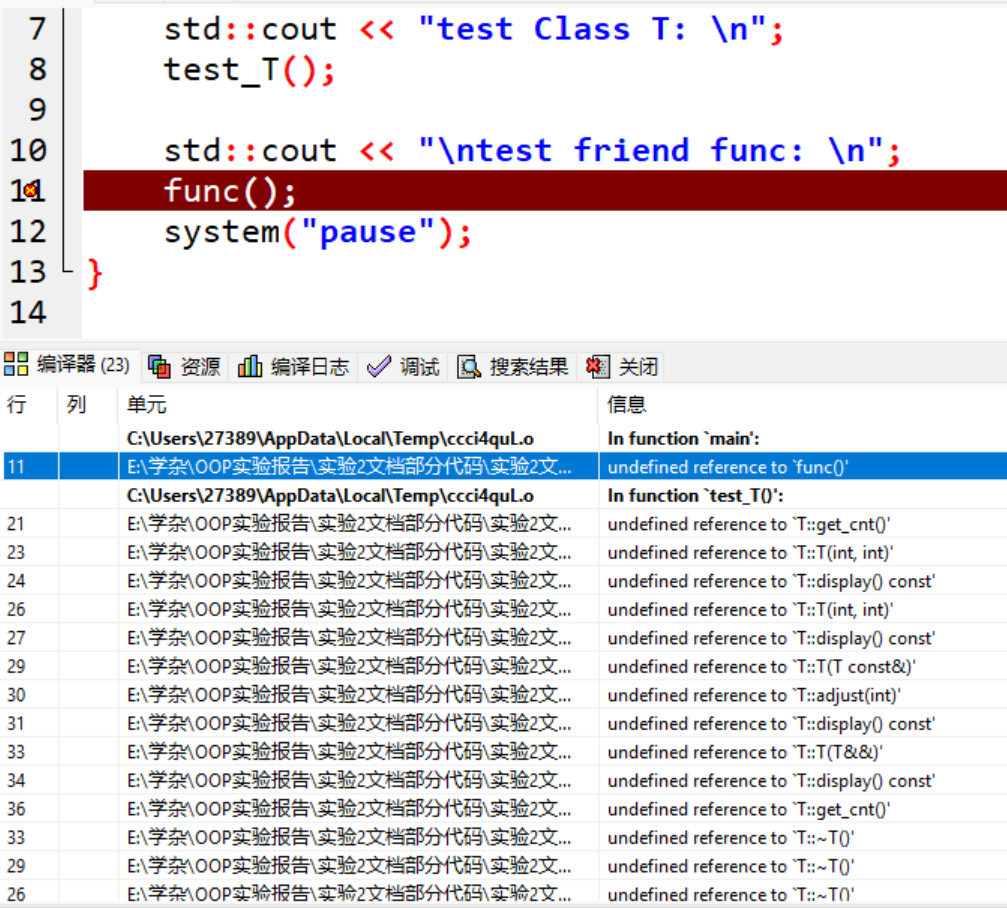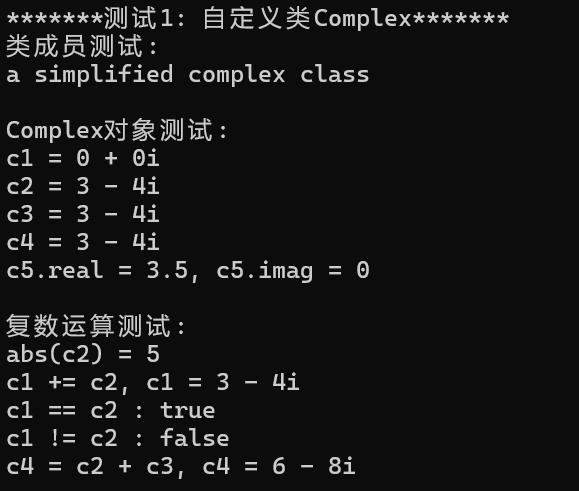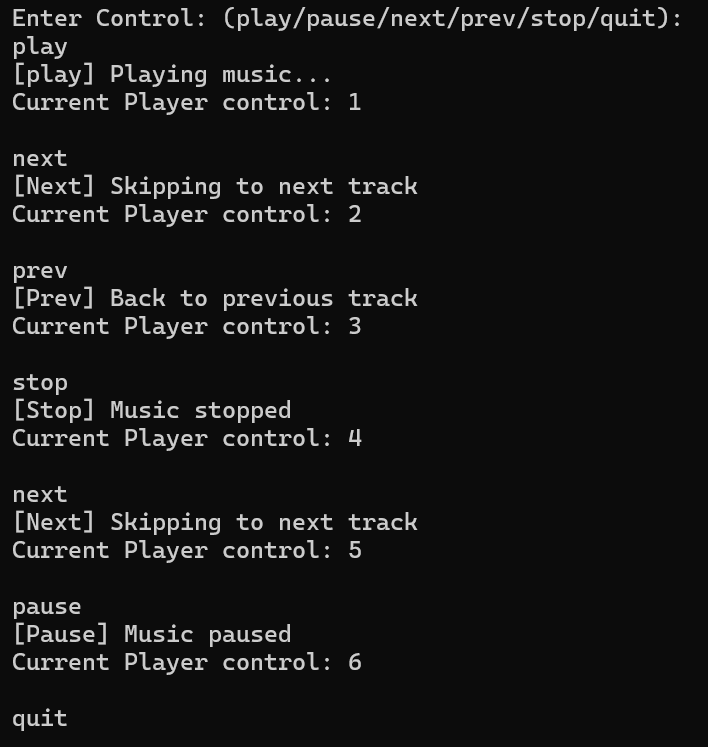实验二
实验任务1
源代码
T.cpp
#include "T.h" #include <iostream> #include <string> // 类T实现 // static成员数据类外初始化 const std::string T::doc{"a simple class sample"}; const int T::max_cnt = 999; int T::cnt = 0; // 类方法 int T::get_cnt() { return cnt; } // 对象方法 T::T(int x, int y): m1{x}, m2{y} { ++cnt; std::cout << "T constructor called.\n"; } T::T(const T &t): m1{t.m1}, m2{t.m2} { ++cnt; std::cout << "T copy constructor called.\n"; } T::T(T &&t): m1{t.m1}, m2{t.m2} { ++cnt; std::cout << "T move constructor called.\n"; } T::~T() { --cnt; std::cout << "T destructor called.\n"; } void T::adjust(int ratio) { m1 *= ratio; m2 *= ratio; } void T::display() const { std::cout << "(" << m1 << ", " << m2 << ")" ; } // 普通函数实现 void func() { T t5(42); t5.m2 = 2049; std::cout << "t5 = "; t5.display(); std::cout << '\n'; }
T.h
#pragma once #include <string> // 类T: 声明 class T { // 对象属性、方法 public: T(int x = 0, int y = 0); // 普通构造函数 T(const T &t); // 复制构造函数 T(T &&t); // 移动构造函数 ~T(); // 析构函数 void adjust(int ratio); // 按系数成倍调整数据 void display() const; // 以(m1, m2)形式显示T类对象信息 private: int m1, m2; // 类属性、方法 public: static int get_cnt(); // 显示当前T类对象总数 public: static const std::string doc; // 类T的描述信息 static const int max_cnt; // 类T对象上限 private: static int cnt; // 当前T类对象数目 // 类T友元函数声明 friend void func(); }; // 普通函数声明 void func();
#include "T.h" #include <iostream> void test_T(); int main() { std::cout << "test Class T: \n"; test_T(); std::cout << "\ntest friend func: \n"; func(); system("pause"); } void test_T() { using std::cout; using std::endl; cout << "T info: " << T::doc << endl; cout << "T objects'max count: " << T::max_cnt << endl; cout << "T objects'current count: " << T::get_cnt() << endl << endl; T t1; cout << "t1 = "; t1.display(); cout << endl; T t2(3, 4); cout << "t2 = "; t2.display(); cout << endl; T t3(t2); t3.adjust(2); cout << "t3 = "; t3.display(); cout << endl; T t4(std::move(t2)); cout << "t4 = "; t4.display(); cout << endl; cout << "test: T objects'current count: " << T::get_cnt() << en
运行结果

回答问题1:
会报错,截图如下

将上面两张截图结合可知,func函数没有在范围内声明,使得对于task1而言func是未定义的函数也就无法正常编译,进而报错。
回答问题2:
普通构造函数T(int x = 0, int y = 0)
功能:初始化变量,既可以定义空变量也可以定义带参数值的变量。
调用时机:在创建变量时调用。
复制构造函数:T(const T &t)
功能:使用一个已定义的变量来初始化新变量。其中T t1(t2)是把变量t2复制到t1中。
调用时机:当把已定义的变量拷贝到初始化新变量中时调用。
移动构造函数:T(T &&t)
功能:用右值变量来初始化新变量。
调用时机:当用一个变量的右值(如std::move(t2))初始化新对象时。
析构函数:~T()
功能:在程序退出时自动销毁过程中定义的变量。
调用时机:当变量离开其作用域或程序退出时。
3.编译失败,编译结果如下

将代码移动后,函数在h中被重复了定义两次,因此出错。
实验任务2
源代码
Complex.cpp
#include "Complex.h" #include <iostream> #include <cmath> #include <iomanip> const std::string Complex::doc = "a simplified complex class"; Complex::Complex() : real(0.0), imag(0.0) {} Complex::Complex(double real) : real(real), imag(0.0) {} Complex::Complex(double real, double imag) : real(real), imag(imag) {} Complex::Complex(const Complex& other) : real(other.real), imag(other.imag) {} double Complex::get_real() const { return real; } double Complex::get_imag() const { return imag; } void Complex::add(const Complex& other) { real += other.real; imag += other.imag; } void output(const Complex& c) { std::cout << c.real; if (c.imag >= 0) { std::cout << " + " << c.imag << "i"; } else { std::cout << " - " << -c.imag << "i"; } } double abs(const Complex& c) { return std::sqrt(c.real * c.real + c.imag * c.imag); } Complex add(const Complex& c1, const Complex& c2) { return Complex(c1.real + c2.real, c1.imag + c2.imag); } bool is_equal(const Complex& c1, const Complex& c2) { return (c1.real == c2.real) && (c1.imag == c2.imag); } bool is_not_equal(const Complex& c1, const Complex& c2) { return !is_equal(c1, c2); }
Complex.h
#pragma once #include <string> class Complex { public: static const std::string doc; Complex(); Complex(double real); Complex(double real, double imag); Complex(const Complex& other); double get_real() const; double get_imag() const; void add(const Complex& other); friend void output(const Complex& c); friend double abs(const Complex& c); friend Complex add(const Complex& c1, const Complex& c2); friend bool is_equal(const Complex& c1, const Complex& c2); friend bool is_not_equal(const Complex& c1, const Complex& c2); private: double real; double imag; };
task2.cpp
#include "Complex.h" #include <iostream> #include <iomanip> #include <complex> void test_Complex(); void test_std_complex(); int main() { std::cout << "*******测试1: 自定义类Complex*******\n"; test_Complex(); std::cout << "\n*******测试2: 标准库模板类complex*******\n"; test_std_complex(); } void test_Complex() { using std::cout; using std::endl; using std::boolalpha; cout << "类成员测试: " << endl; cout << Complex::doc << endl << endl; cout << "Complex对象测试: " << endl; Complex c1; Complex c2(3, -4); Complex c3(c2); Complex c4 = c2; const Complex c5(3.5); cout << "c1 = "; output(c1); cout << endl; cout << "c2 = "; output(c2); cout << endl; cout << "c3 = "; output(c3); cout << endl; cout << "c4 = "; output(c4); cout << endl; cout << "c5.real = " << c5.get_real() << ", c5.imag = " << c5.get_imag() << endl << endl; cout << "复数运算测试: " << endl; cout << "abs(c2) = " << abs(c2) << endl; c1.add(c2); cout << "c1 += c2, c1 = "; output(c1); cout << endl; cout << boolalpha; cout << "c1 == c2 : " << is_equal(c1, c2) << endl; cout << "c1 != c2 : " << is_not_equal(c1, c2) << endl; c4 = add(c2, c3); cout << "c4 = c2 + c3, c4 = "; output(c4); cout << endl; } void test_std_complex() { using std::cout; using std::endl; using std::boolalpha; cout << "std::complex<double>对象测试: " << endl; std::complex<double> c1; std::complex<double> c2(3, -4); std::complex<double> c3(c2); std::complex<double> c4 = c2; const std::complex<double> c5(3.5); cout << "c1 = " << c1 << endl; cout << "c2 = " << c2 << endl; cout << "c3 = " << c3 << endl; cout << "c4 = " << c4 << endl; cout << "c5.real = " << c5.real() << ", c5.imag = " << c5.imag() << endl << endl; cout << "复数运算测试: " << endl; cout << "abs(c2) = " << abs(c2) << endl; c1 += c2; cout << "c1 += c2, c1 = " << c1 << endl; cout << boolalpha; cout << "c1 == c2 : " << (c1 == c2)<< endl; cout << "c1 != c2 : " << (c1 != c2) << endl; c4 = c2 + c3; cout << "c4 = c2 + c3, c4 = " << c4 << endl; }
运行结果


回答问题1:
显然,在使用形式上,标准库模板类complex更简洁。其一是标准库complex支持运算符重载,因而可以直接使用自然数学符号来简化编写;其二是输出部分更直接,不用额外去写一个output。
而函数和运算内在是有关联的。标准库complex的运算符重载使运算更方便简洁地实现与自定义函数编写同等的功能。
回答问题2:
2.1:是。output()需要访问实部和虚部来格式化输出
abs()需要访问实部和虚部来计算模
add()需要访问两个复数的实部和虚部来执行加法运算
上述函数都要访问实部和虚部,设置为友元可以让函数调用起来更快捷。
2.2: 查阅cppreference后可知,标准库std::complex没有将abs设为友元函数。
因为在complex中有对应的接口,不需要设置。
2.3:首先要明确friend会破坏类的封装性,相应的可以提高函数调用的效率。
故当非成员函数需要直接访问对象的私有数据时;
或需要避免通过公有接口间接访问私有数据时可以考虑使用friend。
回答问题3:
构造对象时禁用=形式会导致所有复制操作都被禁用,我不清楚应该怎么调整,查了一下之后说“将单参数构造函数标记为explicit,这只会禁用从double到Complex的隐式转换;保留拷贝构造函数,因此Complex c4 = c2;仍然可以正常工作”。
实验任务3
源代码
PlayerControl.cpp
#include "PlayerControl.h" #include <iostream> #include <algorithm> int PlayerControl::total_cnt = 0; PlayerControl::PlayerControl() {} // 待补足 // 1. 将输入字符串转为小写,实现大小写不敏感 // 2. 匹配"play"/"pause"/"next"/"prev"/"stop"并返回对应枚举 // 3. 未匹配的字符串返回ControlType::Unknown // 4. 每次成功调用parse时递增total_cnt ControlType PlayerControl::parse(const std::string& control_str) { std::string lower_str = control_str; std::transform(lower_str.begin(), lower_str.end(), lower_str.begin(), ::tolower); if (lower_str == "play") { total_cnt++; return ControlType::Play; } else if (lower_str == "pause") { total_cnt++; return ControlType::Pause; } else if (lower_str == "next") { total_cnt++; return ControlType::Next; } else if (lower_str == "prev") { total_cnt++; return ControlType::Prev; } else if (lower_str == "stop") { total_cnt++; return ControlType::Stop; } else { total_cnt++; return ControlType::Unknown; } } void PlayerControl::execute(ControlType cmd) const { switch (cmd) { case ControlType::Play: std::cout << "[play] Playing music...\n"; break; case ControlType::Pause: std::cout << "[Pause] Music paused\n"; break; case ControlType::Next: std::cout << "[Next] Skipping to next track\n"; break; case ControlType::Prev: std::cout << "[Prev] Back to previous track\n"; break; case ControlType::Stop: std::cout << "[Stop] Music stopped\n"; break; default: std::cout << "[Error] unknown control\n"; break; } } int PlayerControl::get_cnt() { return total_cnt; }
PlayerControl.h
#pragma once #include <string> enum class ControlType {Play, Pause, Next, Prev, Stop, Unknown}; class PlayerControl { public: PlayerControl(); ControlType parse(const std::string& control_str); // 实现std::string --> ControlType转换 void execute(ControlType cmd) const; // 执行控制操作(以打印输出模拟) static int get_cnt(); private: static int total_cnt; };
task3.cpp
#include "PlayerControl.h" #include <iostream> void test() { PlayerControl controller; std::string control_str; std::cout << "Enter Control: (play/pause/next/prev/stop/quit):\n"; while(std::cin >> control_str) { if(control_str == "quit") break; ControlType cmd = controller.parse(control_str); controller.execute(cmd); std::cout << "Current Player control: " << PlayerControl::get_cnt() << "\n\n"; } } int main() { test(); }
运行结果


思考题:只要修改void PlayerControl::execute(ControlType cmd) const{}函数中每个case的输出,改成emoji和文字一起输出就可以了,但是不同编译环境emoji对应的值应该有所不同,需要先查询对应的值再根据环境编写。
实验任务4
源代码
Fraction.h
#pragma once #include <string> class Fraction { private: int up; int down; void reduce(); static int gcd(int a, int b); public: static const std::string doc; Fraction(int numerator = 0, int denominator = 1); Fraction(const Fraction& other) = default; int get_up() const; int get_down() const; Fraction negative() const; friend void output(const Fraction& f); friend Fraction add(const Fraction& f1, const Fraction& f2); friend Fraction sub(const Fraction& f1, const Fraction& f2); friend Fraction mul(const Fraction& f1, const Fraction& f2); friend Fraction div(const Fraction& f1, const Fraction& f2); }; void output(const Fraction& f); Fraction add(const Fraction& f1, const Fraction& f2); Fraction sub(const Fraction& f1, const Fraction& f2); Fraction mul(const Fraction& f1, const Fraction& f2); Fraction div(const Fraction& f1, const Fraction& f2);
Fraction.cpp
#include "Fraction.h" #include <iostream> #include <stdexcept> #include <cmath> const std::string Fraction::doc = "Fraction类 v 0.01版. 目前仅支持分数对象的构造、输出、加/减/乘/除运算."; int Fraction::gcd(int a, int b) { a = std::abs(a); b = std::abs(b); while (b != 0) { int temp = b; b = a % b; a = temp; } return a; } void Fraction::reduce() { if (down == 0) { throw std::invalid_argument("分母不能为0"); } if (down < 0) { up = -up; down = -down; } int common = gcd(up, down); if (common != 0) { up /= common; down /= common; } } Fraction::Fraction(int numerator, int denominator) : up(numerator), down(denominator) { reduce(); } int Fraction::get_up() const { return up; } int Fraction::get_down() const { return down; } Fraction Fraction::negative() const { return Fraction(-up, down); } void output(const Fraction& f) { if (f.down == 1) { std::cout << f.up; } else { std::cout << f.up << "/" << f.down; } } Fraction add(const Fraction& f1, const Fraction& f2) { int new_up = f1.up * f2.down + f2.up * f1.down; int new_down = f1.down * f2.down; return Fraction(new_up, new_down); } Fraction sub(const Fraction& f1, const Fraction& f2) { int new_up = f1.up * f2.down - f2.up * f1.down; int new_down = f1.down * f2.down; return Fraction(new_up, new_down); } Fraction mul(const Fraction& f1, const Fraction& f2) { int new_up = f1.up * f2.up; int new_down = f1.down * f2.down; return Fraction(new_up, new_down); } Fraction div(const Fraction& f1, const Fraction& f2) { if (f2.up == 0) { throw std::invalid_argument("分母不能为0"); } int new_up = f1.up * f2.down; int new_down = f1.down * f2.up; return Fraction(new_up, new_down); }
#include "Fraction.h" #include <iostream> void test1(); void test2(); int main() { std::cout << "测试1: Fraction类基础功能测试\n"; test1(); std::cout << "\n测试2: 分母为0测试: \n"; test2(); } void test1() { using std::cout; using std::endl; cout << "Fraction类测试: " << endl; cout << Fraction::doc << endl << endl; Fraction f1(5); Fraction f2(3, -4), f3(-18, 12); Fraction f4(f3); cout << "f1 = "; output(f1); cout << endl; cout << "f2 = "; output(f2); cout << endl; cout << "f3 = "; output(f3); cout << endl; cout << "f4 = "; output(f4); cout << endl; const Fraction f5(f4.negative()); cout << "f5 = "; output(f5); cout << endl; cout << "f5.get_up() = " << f5.get_up() << ", f5.get_down() = " << f5.get_down() << endl; cout << "f1 + f2 = "; output(add(f1, f2)); cout << endl; cout << "f1 - f2 = "; output(sub(f1, f2)); cout << endl; cout << "f1 * f2 = "; output(mul(f1, f2)); cout << endl; cout << "f1 / f2 = "; output(div(f1, f2)); cout << endl; cout << "f4 + f5 = "; output(add(f4, f5)); cout << endl; } void test2() { using std::cout; using std::endl; Fraction f6(42, 55), f7(0, 3); cout << "f6 = "; output(f6); cout << endl; cout << "f7 = "; output(f7); cout << endl; cout << "f6 / f7 = "; output(div(f6, f7)); cout << endl; }
运行结果

问题回答:
我选择了友元函数来设计,这样函数output、add、sub、mul和div就可以直接访问Fraction对象的up和down成员,同时减少了接口,提高程序运行效率,同时书写方便清晰,易于查错。缺点就是破坏了类的封装性。静态函数和命名空间+自由函数在访问私有数据时的效率都不高,不是要依赖公共接口就是要额外使用函数来访问。
另外关于这题输出结果的最后一行我想不出什么不改动task4.cpp就能实现预期输出的好方法,最后妥协的结果如上。
实验总结
类的实现在实践上比理论上困难很多,准确来讲是挫折不大也不少。首先就是封装,在封装完成前要根据任务目标决定如何封装,有时应该直接写友元。然后就是要注意不同文件间的接口要对应,我在用dev c++写的时候接口写错了对着报错信息找半天没找到错哪,只能说dev c++作为轻量级的编译器错误信息显示还是不够清晰,另外要养成检查头文件的好习惯,我写的时候已经误删过一次头文件了。
另外自定义类函数虽然能实现的功能种类要跟多,但编写更麻烦,查错也很困难,程序运行效率也会相对更低;合理运用函数库已有的函数,如无必要,就不要用自定义函数来实现相同的功能。



 浙公网安备 33010602011771号
浙公网安备 33010602011771号